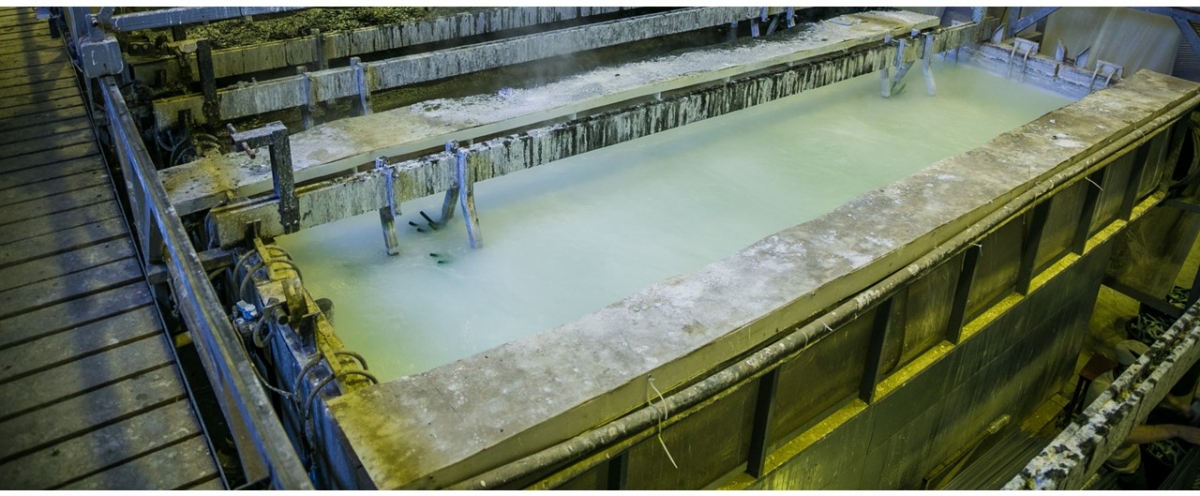Descaling in manufacturing is a process for cleaning unwanted oxide deposits from metal surfaces that have previously been heated, leaving a consistent surface finish. Typically scales form on the metal surface during heat treatment processes. The scales of oxide discolour the metal surface and can compromise further finishing operations.

Hot steel being processed
The possibility of scales compromising further finishing operations makes pre-finishing processes vital, finishing operations like the application of coatings and electroplating. The downstream finishing operations dictates the level of cleanliness required with some finishing processes requiring a particularly high degree of cleanliness.
A range of descaling methods are frequently used during surface processing, all of which have their limitations.
Mechanical cleaning is often used when there is a possibility of the metal in question reacting with chemicals. Scraping machines and wire brushes remove oxide heat scale, but leave microscopic ‘scratch’ marks on the metal surface, which can compromise the adhesion of coatings.
Dry blasting is another mechanical method that results in the generation of large amounts of dust that can result in health and explosion risks. The finish created by dry blasting can be comparatively inconsistent too.

Dry blasting
Chemical cleaning is another frequently used method for cleaning metal surfaces and removing oxide scales, for example mild alkaline solutions like sodium hydroxide, sodium metasilicate, sodium carbonate and sodium phosphate.
The cleaning process can be sped up by the use of stronger concentrations of alkali solution, but cleaning by alkaline solutions usually requires further mechanical cleaning and of course, there’s a huge environmental issue when it comes to the use of such chemicals, including the cost and difficulty of disposal.
The use of acids is another possibility for the removal of oxide scale from metal surfaces, this method is commonly known as ‘pickling.’ Neutralizing remaining alkalis from the alkaline cleaning processes is an additional function of pickling.
Pickling’s typically used for copper, ferrous and aluminium oxides. Descaling metal surfaces is carried out by an acid solution, known as the pickle liquor. However, as with alkaline solutions, there’s significant environmental issues associated with the use of acids and especially the disposal of the waste from the process, known as the ‘pickling sludge.’

Metal pickling
But there is a surface treatment of metals that efficiently removes heat scale whilst leaving the surface of metals uniformly clean, without any damage to the surface of the metal and without any environmental issues in the way of dust, explosion risk or the disposal of harmful chemicals – that is the wet blasting process (otherwise know as vapor blasting).
To understand how wet blasting works, its benefits and how it compares with other surface finishing processes visit our comprehensive wet blasting education page.
Because the abrasive media used in the wet blasting process is combined with water, to create a wet blast slurry, metal surfaces are protected from the creation of the surface ‘scratches’ that are typical of brushing and scraping processes by the cushioning effect of the water in the wet blast slurry.
Another benefit of the wet blast slurry is the elimination of dust from the process making the working environment much safer when compared with dry blast processes – dust in the atmosphere and subsequent explosion risks are completely removed.
Because the wet blasting (vapor blasting) process only uses water, abrasive and pressurised air, there’s no harmful acids or alkalines that are typically an environmental hazard and that can be extremely difficult and expensive to dispose of.
We have a comprehensive range of automatic and manual wet blasting machines (vapor blasting machines) that can quickly and efficiently remove heat scale along whilst carrying out range of other applications depending on the other surface finishing processes required.
Vapormatt Puma+ automatic wet blasting machine
Our range of automatic machines are either specifically designed for certain industries or are more generic machines that can be highly configured to meet the exact requirements of the user. Selecting and / or configuring the right machine for the process is important for surface finish quality and especially for productivity.
One of the main advantages of automation is its ability to deliver a consistent finish over the entire surface of the component in question for perfect component cleaning. Repeatability is another benefit, which means the same consistent finish is delivered every time. This ensures head scale is thoroughly and consistently removed from every component.
Our range of manual machines can effectively remove heat scale too. Manual component cleaning machines are ideal for lower volume work or where the type of component differs from one surface finishing operation to the next. As with our automatic machines there’s a range of working envelopes available, so no matter how small or large your components, we have automatic wet blasting systems or manual machine wet blasting cabinets (vapor blasting cabinets) that can remove heat scale leaving a high-quality surface finish that’s perfect for downstream processes. It’s worth noting that as well leaving a consistent clean surface, it leaves a highly reactive surface too that’s perfect for the applications of coatings like paint and electroplating.